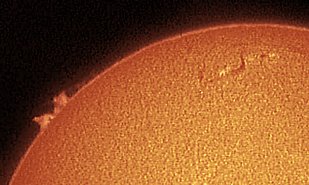
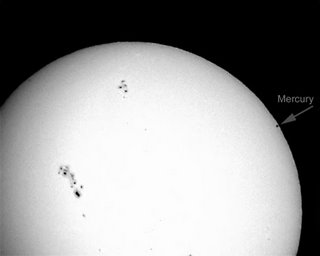
Which view of the sun would you rather have? On the bottom is a photoI took during the 1999 Mercury transit, using a 3.5 Questar, one of the best Maksutov-Cassegrain telescopes available. It is a great shot, but besides tiny Mercury, all you see is a nice complex of sunspots. The problem is that even with the excellent filter of the Questar, you are looking at the sun in White Light. In order to see solar prominences and filaments you have to look at the sun in H-Alpha.
The other photo is one I took this week using a new telescope.
Questar does a nice job with sun spots, but I wanted to see prominences, filaments, plage and flares -- and sunspots. The picture below was found on www.coronadofilters.com.
Coronado produces PSTs, or Personal Solar Telescopes-- a wonderful telescope for solar viewing.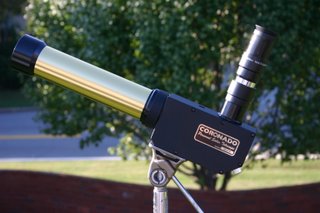 PSTs allow a person to view the sun in the H-Alpha bandwidth of the spectrum. Questar offered an H-Alpha filter. The only problem is that it costs about $6,000 to add this to an existing Questar telescope.
PSTs allow a person to view the sun in the H-Alpha bandwidth of the spectrum. Questar offered an H-Alpha filter. The only problem is that it costs about $6,000 to add this to an existing Questar telescope.
Coronado offers a much more affordable option. Their PSTs don't have a lot of power and magnification, but when looking at the sun it is not magnification you need as much as the filter.
I ordered one of these PSTs. It came on Monday.
I woke up on Monday,  knowing it would arrive sometime during the day, and was distressed to see the gray clouds covering the sky. But by 9 AM, the sky went from cloudy to clear blue within a short time -- like a curtain being opened.
knowing it would arrive sometime during the day, and was distressed to see the gray clouds covering the sky. But by 9 AM, the sky went from cloudy to clear blue within a short time -- like a curtain being opened.
I had a chance to spend a couple of hours playing with my new toy.
The PST is simple to use. The instruction manual is really just a small single sheet, making a tri-fold pamphlet. There is not much to know about how to use it. However, I did come to appreciate what the tiny instruction manual meant when it said, "It can take time to 'train' one's eye for H-Alpha viewing." My first reaction to looking through the telescope was disappointment. All I saw was an orange-red sphere. It took a while to understand how to look through the new telescope.
The PST is simple to use, even more so that a Questar. When I use the Questar to look at the sun, I have to screw in the solar filter and remember to flip the hinge operated, built-in solar filter over the view finder. (Johnny Carson is responsible for that addition to Questar. He was an avid astronomer and when he bought his Questar in the early 1960's he personally complained about the danger of not having a built in solar filter for the view finder).
With the PST, the filter is built in. Period.
Coronado has also come up with a special view finder. There is a pinhole-size opening in the base of the telescope that reflects the sun's image on a screen.
After putting it on the tripod, I located the sun using a special view finder Coronado has devised.
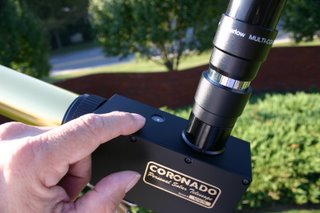
As you can see in the picture above, the tiny, circular screen shows a tiny solar image. Center that and the sun should be visible in the eyepiece. It is handy, in that you can move the telescope's position and look through the eyepiece while keeping the other eye open to look at the view finder screen.
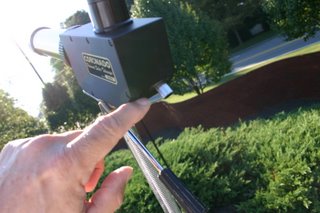
The focus knob, shown here, is conveniently located. To focus the PST, don't look at the body of the sun, but along the limb. When the limb is sharp, the telescope is in focus.
My initial disapointment is that nothing came into view once I focused the telescope.
The instructions provided by Coronado says that there is another important adjustment the observer can make, in addition to focusing.
It is a knob encircling the tube of the telescope called the tuner -- something not found on other telescopes. It rotates or tunes the filter. Coronado adjusts this at their factory and says that you normally would never need to adjust the tuner. After several minutes of being frustrated with nothing to really see, I dared to adjust the tuner.
Everything came into view! There were prominences and filiments all over the surface of the sun. The entire sun had a distinct texture to it.
This telescope was reviewed in Sky and Telescope magazine a year or two ago, and the reviewer's main criticism is what Coronado calls the "sweet spot." When the telescope is tuned and focused, the eye will see filiments and prominences in the "sweet spot" of the eyepiece. As the earth turns and the sun seems to move out of the view of the telescope, those solar features will appear to grow and then disappear.
It takes a while to become accustomed to the sweet spot, and I don't pretend that I have gotten used to it after only two days.
The closest I can compare it with is looking at Andromeda Galaxy, M-31. That dark sky object is visible with the unaided eye -- or was before all the street lights were set up. Even in a rather small telescope, the image is so large that the best way to look at it is to turn off the clock-drive and let the earth's rotation turn the telescope so that the image slowly comes into and then out of view while the observer just sits there and watches the show.
Setting the telescope on the edge of the sun the observer can watch the sun come in and then out of view. The sweet spot will highlight different features on the face of the sun.
It is taking some time to master photography with the PST -- this image here is my very first attempt. It shows a prominence along the limb, or edge, of the sun, but it doesn't to justice to what I actually saw. The more recent photos are a vast improvement over this first try.
The PST comes with a single eyepiece, a 20mm (20x) 1.25" Kellner. I added a 2x Barlow and enjoyed the viewing much more with the increased power. Coronado recommends buying their eyepieces, but I found that any of my 1.25" occulars were good.
Amateur astronomers are not usually as interested in magnification as the general public, because there are other things more important to us, such as resolution. Still, the question is a good one -- what is the magnifying power of the PST?
The formula to calculate a telescope's magnification power is M= fe/fo, or magnifcation equals fe, which is the focal length of the eyepiece, divided by fo, which is the focal length of the objective lense. The PST has a focal length of 400mm. Using the 20mm eyepiece, that is a small magnification power of only 20x. The barlow I have is a 2x, which increases the power by having a deminishing effect on the eyepiece focal length. In other words, the 2omm eyepiece with a barlow becomes a 10mm eyepiece -- resulting in a magnification of 40. It is still small, but sufficient for the sun. I have a 12.5mm eyepiece, which is the smallest I have -- so with a 2x barlow, that becomes a 8.25mm for a power of roughly 48.5. That's quite a bit different from the magnification of my 3.5 Questar, with which I can achieve a magnification of about 360x, or the 10 inch reflector I have that can reach about the same, but captures more light.
But I digress.
Getting back to the PST, I was particularly pleased with the video images I took using a Meade electronic eyepiece -- it has a 320x240 pixel CMOS monocrome imaging sensor. Even though it records the image in black and white, the detail of the image was better than I was able to get on the first several tries I made with the digital still-camera.
Last night was a clear night, so I continued to take a few photos of the from Arp's Atlas of Peculiar Galaxies. Below is Arp 049, NGC 7545. The duration of the image was ten minutes, and it still is a bit of a disappointment.
Next is Arp 28, NGC 7678.
NGC7678 is a face-on spiral galaxy in Pegasus. it has an arm that is nearly as massive as the rest of the galaxy, which I believe is why Arp included it in his list.
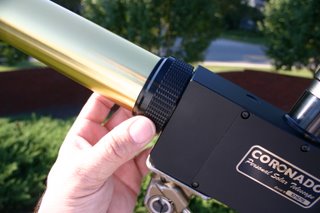

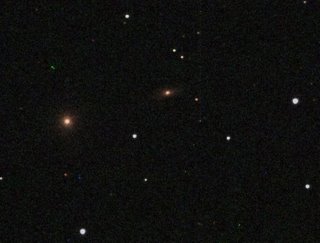
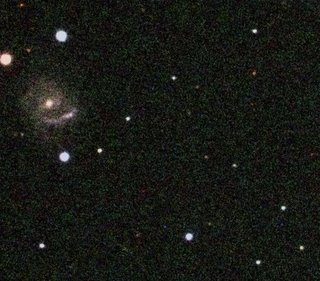
1 comment:
Did you take a photo of Arp galaxies with the PST?? Only a 10 minute exposure?
Post a Comment